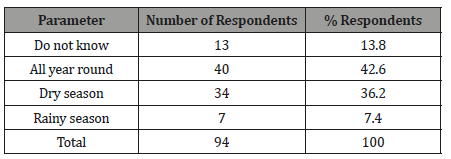
Authored by J Atawalna*
Introduction
The donkey (Equus asinus) is indigenous to the African continent and is believed to have originated from the Nubian wild ass. The largest population of donkeys in the world are found in China, while in Africa, Ethiopia has the largest population estimated to be over five (5) million [1]. In Ghana, an estimated population of 13,100 donkeys are reared mainly in the Northern, Upper East and Upper West regions [2] Donkeys were introduced to the southern parts of Ghana for animal and traction purposes [3].Throughout the world, donkeys have been utilized for multi-purpose activities including as guard animals for protecting small ruminants, companion animals, draught animals and sport animals [4].Despite their vast economic importance, the donkey population in Africa has been declining over the decades. This has been attributed to the illegal trade in donkey meat for export to China. There is therefore the need to maintain this current population by focusing on donkey reproduction and breeding. Attempts at improving donkey reproductive performance must take into cognisance, the indigenous knowledge of donkey reproductive physiology and breeding. Unfortunately, such information is very scanty in literature. The available information on donkey reproduction is derived from studies done on horses, although there is a fundamental difference between them. The purpose of this study was to investigate the knowledge of donkey owners on donkey reproduction and reproductive health disorders in Northern Ghana.
Materials and Methods
The study was conducted in the Builsa North district of the Upper East region of Ghana from January to March, 2015. The district lies between longitudes 10 05’’ West and 10 35” West and latitudes 100 20” North and covers an estimated land area of 816.44030 km2 [5]. This district was purposively selected due to its great agricultural potential and location. It is located approximately Forty-Five (45) kilometeres from the Upper East regional capital of Bolgatanga.The respondents were randomly selected, based on an evidence of donkey rearing and interviewed using semi-structured questionnaire, designed to capture information on farmers socio-economic characteristics and their knowledge in donkey reproduction and reproductive health disorders. Direct observation of the animals was done in order to assess the nature of the housing and husbandry conditions where applicable. The results obtained were analysed using descriptive statistics.
Results and Discussion
Socio-economic characteristics of donkey owners
The respondents interviewed consisted of 69 males and 25 females. Their ages ranged from 25 to 73 years with an average age of 43.2 years. The average age of donkey owners in this study was lower than the age of more than 60 years in Greece [6]. The majority of respondents (47.9%) had no formal education, 31.9% had basic education while 20.2% were graduates of Teacher training or Agricultural colleges. The respondents kept other livestock such as cattle, sheep, goats, chicken and guinea fowls. The herd size ranges from 1-19 donkeys per individual with the majority keeping an average of 4 donkeys per household. The respondents owned a total of 674 donkeys comprising of 338 female and 236 males.
To read more about this article...Open access Journal of Animal Husbandry & Dairy Science
Please follow the URL to access more information about this article




No comments:
Post a Comment